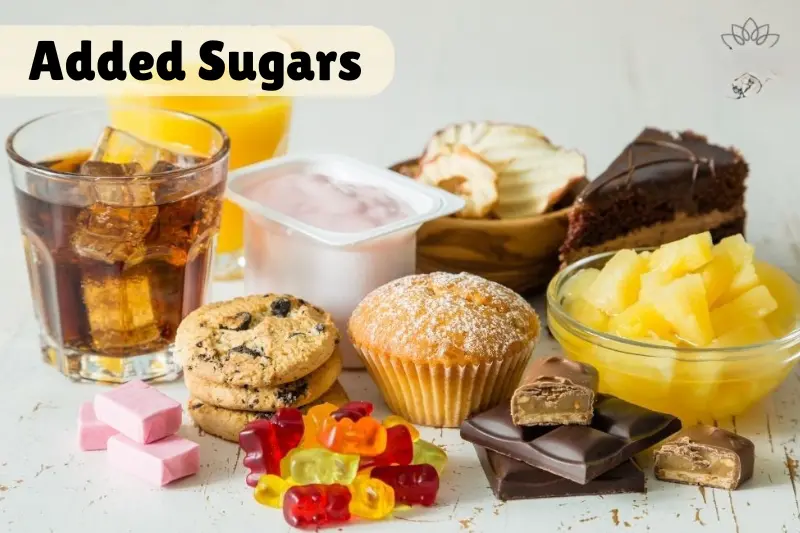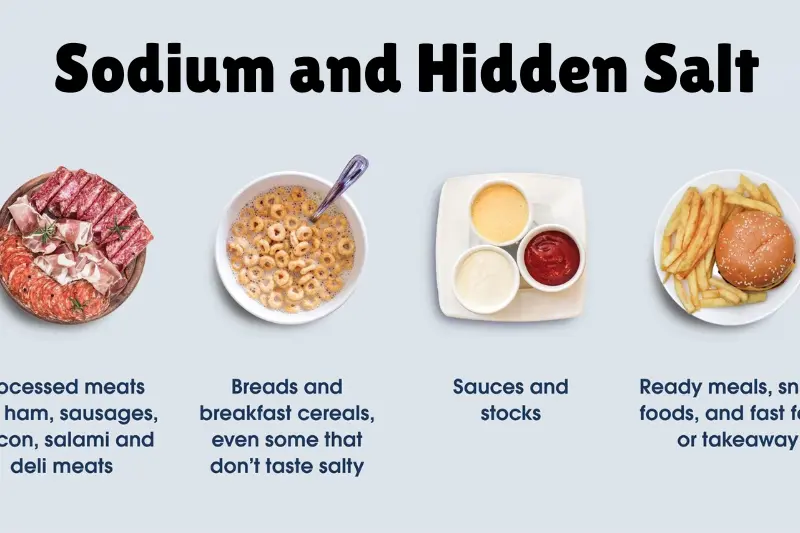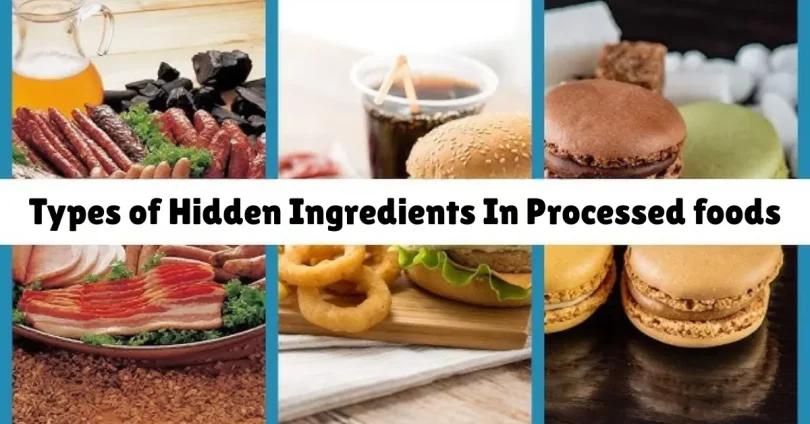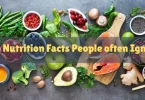Processed foods are a major part of modern diets. They are convenient, easy to store, and ready to eat, but often come with hidden surprises. While these foods save time, they frequently contain ingredients that are not obvious at first glance. Understanding the types of hidden ingredients in processed foods is essential for making healthier choices, maintaining good nutrition, and protecting your long-term health.
In this article, we’ll break down the most common hidden ingredients, their sources, and their potential health effects.
1. Added Sugars

One of the most prevalent hidden ingredients in processed foods is sugar. While it may be listed on the label, it often appears under different names to make products seem healthier.
Common forms of hidden sugars include:
- High fructose corn syrup
- Cane sugar, raw sugar, evaporated cane juice
- Dextrose, maltose, glucose
- Fruit juice concentrates
Health impact:
Excess consumption of added sugars can lead to a variety of health problems, including:
- Weight gain and obesity
- Increased risk of type 2 diabetes
- Tooth decay and cavities
- Increased risk of heart disease
Sugars are often added to cereals, yogurt, sauces, and beverages, making it difficult to know how much sugar you’re really consuming.
2. Refined Grains and Flours
Processed foods often replace nutrient-rich whole grains with refined grains. These grains are stripped of fiber, vitamins, and minerals during processing to improve texture and shelf life.
Examples of refined grains in processed foods:
- White flour
- Enriched wheat flour
- White rice and pasta
Health impact:
Consuming refined grains regularly can cause:
- Rapid spikes in blood sugar levels
- Reduced digestive health due to low fiber
- Lower intake of essential nutrients
Refined grains are common in bread, crackers, pastries, and pasta.
3. Artificial Sweeteners
To reduce calories, many processed foods include artificial sweeteners. While they provide sweetness without sugar, they may have hidden consequences.
Common artificial sweeteners include:
- Aspartame
- Sucralose
- Saccharin
- Acesulfame potassium
Health impact:
Artificial sweeteners can:
- Alter gut bacteria, affecting digestion and immunity
- Potentially increase cravings for sweet foods
- Affect appetite regulation and long-term weight management
They are commonly found in diet sodas, sugar-free snacks, and low-calorie desserts.
You may also like to read this:
Why People Prefer Ready-To-Eat Meals For Busy Lifestyles
13 Best Healthy Alternatives To Processed Meals For Everyone
Top Processed Food Brands In The Market Leading Innovation
What Nutrition Facts Mean on Food Labels – Complete Guide
How To Read Nutrition Facts Properly: Full Guide
4. Hydrogenated and Trans Fats
Trans fats are often added to processed foods to improve texture, taste, and shelf life. These fats are considered highly unhealthy.
Where they are commonly hidden:
- Margarine
- Baked goods like cookies, pastries, and cakes
- Packaged snacks, chips, and fried foods
Health impact:
Trans fats can:
- Increase LDL (bad) cholesterol
- Decrease HDL (good) cholesterol
- Increase the risk of heart disease, stroke, and inflammation
Always check the ingredient list for “partially hydrogenated oils,” which indicates trans fats.
5. Sodium and Hidden Salt

Processed foods frequently contain hidden sodium, not just in table salt but under other chemical names.
Common hidden sodium sources include:
- Monosodium glutamate (MSG)
- Sodium benzoate
- Disodium phosphate
- Baking soda (sodium bicarbonate)
Health impact:
High sodium intake can lead to:
- High blood pressure
- Increased risk of heart disease and kidney problems
- Water retention and bloating
Canned soups, processed meats, frozen meals, and sauces often contain high hidden sodium levels.
6. Preservatives
Preservatives are used to extend the shelf life of processed foods, but they can sometimes cause health concerns.
Common preservatives in processed foods:
- Sodium nitrite/nitrate (in processed meats)
- BHA (butylated hydroxyanisole) and BHT (butylated hydroxytoluene)
- Potassium sorbate
- Sulfites
Health impact:
Certain preservatives may:
- Trigger allergic reactions
- Affect gut health
- Have potential links to chronic illnesses if consumed in excess
Packaged snacks, canned foods, and processed meats are common sources.
7. Artificial Colors and Flavors
Artificial colors and flavors are used to make processed foods look and taste more appealing.
Examples include:
- Red 40, Yellow 5, Blue 1
- Vanillin (synthetic vanilla)
- Ethyl vanillin
Health impact:
Some artificial colors and flavors can:
- Cause allergic reactions or sensitivities
- Trigger hyperactivity in children
- Affect metabolism and overall health
They are found in candies, beverages, packaged desserts, and flavored snacks.
8. Emulsifiers and Stabilizers
Emulsifiers and stabilizers are added to maintain texture and prevent ingredients from separating.
Examples include:
- Lecithin
- Carrageenan
- Mono- and diglycerides
- Xanthan gum
Health impact:
Certain emulsifiers may:
- Alter gut microbiota
- Increase inflammation in the digestive system
- Contribute to digestive discomfort
They are commonly found in ice cream, salad dressings, mayonnaise, and baked goods.
9. Flavor Enhancers
Flavor enhancers improve taste and can mask unhealthy ingredients in processed foods.
Examples include:
- Monosodium glutamate (MSG)
- Disodium inosinate
- Disodium guanylate
Health impact:
Overconsumption may cause:
- Headaches
- Nausea
- Sensitivity reactions in some individuals
They are widespread in savory snacks, soups, sauces, and processed meals.
10. Sugar Alcohols
Sugar alcohols are often used in sugar-free or low-calorie foods to provide sweetness without sugar.
Common sugar alcohols:
- Sorbitol
- Xylitol
- Mannitol
- Erythritol
Health impact:
In sensitive individuals, sugar alcohols may:
- Cause bloating, gas, or diarrhea
- Lead to digestive discomfort if consumed in large amounts
They are commonly found in sugar-free gums, candies, and diet foods.
How to Protect Yourself from Hidden Ingredients in Processed Foods
- Read labels carefully – Learn to recognize hidden sugars, fats, and preservatives.
- Choose whole foods – Fresh fruits, vegetables, whole grains, and lean proteins are naturally low in hidden ingredients.
- Limit processed and packaged foods – Preparing meals at home reduces your exposure to hidden additives.
- Be cautious of “low-fat” or “sugar-free” labels – These products often include hidden artificial ingredients.
- Educate yourself on food additives – Knowing the common hidden ingredients helps you make healthier choices.
Conclusion
Understanding the types of hidden ingredients in processed foods is vital for maintaining a healthy diet and protecting your long-term well-being. From added sugars and trans fats to artificial flavors and preservatives, these hidden components can significantly impact your health.
By learning to read labels, choosing whole and minimally processed foods, and staying informed, you can make smarter choices and reduce your exposure to these hidden ingredients.
FAQs
1. What are hidden ingredients in processed foods?
Hidden ingredients are substances added to processed foods that are not obvious from the product name or appearance. They include additives like sugars, preservatives, artificial colors, flavor enhancers, and emulsifiers, which may affect health if consumed in excess.
2. Why are hidden ingredients added to processed foods?
Manufacturers add hidden ingredients to:
Improve taste and texture
Extend shelf life
Enhance appearance and color
Maintain consistency and prevent separation
These additives make processed foods more appealing and long-lasting but may compromise nutrition.
3. How can I identify hidden sugars in processed foods?
Hidden sugars often appear under different names on labels, such as:
High fructose corn syrup
Dextrose, maltose, glucose
Fruit juice concentrates
Reading ingredient lists carefully and looking for multiple sugar sources is key.
4. Are all preservatives harmful?
Not all preservatives are harmful, but some synthetic preservatives like BHA, BHT, sodium nitrite, and sulfites may cause allergic reactions or have potential long-term health risks if consumed in large amounts.
5. What are common hidden fats in processed foods?
Hydrogenated oils and trans fats are common hidden fats. Look for terms like “partially hydrogenated oil” on labels. These fats increase bad cholesterol (LDL) and reduce good cholesterol (HDL), increasing the risk of heart disease.




